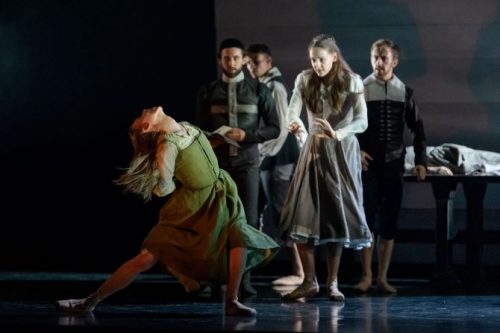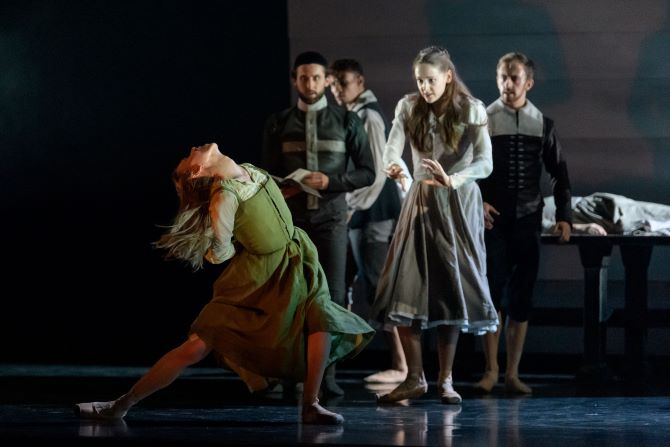 United Kingdom Arthur Miller’s The Crucible (choreography by Helen Pickett and music by Peter Salem): Dancers of Scottish Ballet, Scottish Ballet Orchestra / Daniel Parkinson (conductor). Edinburgh Festival Theatre, 17.10.2019 (SRT)
United Kingdom Arthur Miller’s The Crucible (choreography by Helen Pickett and music by Peter Salem): Dancers of Scottish Ballet, Scottish Ballet Orchestra / Daniel Parkinson (conductor). Edinburgh Festival Theatre, 17.10.2019 (SRT)

Production:
Choreographer – Helen Pickett
Set and Costume designer – Emma Kingsbury
Set and Lighting designer – David Finn
Cast:
Abigail – Constance Devernay
John Proctor – Barnaby Rook-Bishop
Elizabeth Proctor – Bethany Kingsley-Garner
Tituba – Risham Benjamin
Mary – Anna Williams
Rev. Parris – Jamiel Laurence
2019 has been a big year for Scottish Ballet. Not only is this the company’s 50th anniversary but, as part of that, their big production of The Crucible was given centre stage at the Edinburgh International Festival and gained accolades all round. I didn’t get to see it in the summer, so hoped to see it later in the season, as it is pretty normal for Scottish Ballet’s festival shows to enter their normal season rep in Glasgow. It is a sign of the show’s popularity, however, that I didn’t even have to get on the train to see it: in a highly unusual move, they brought the show back to Edinburgh, and it is playing for two nights in a packed Festival Theatre.
Rightly so, because it is their strongest adaptation in a long time. There is always a dilemma in adapting a pre-existing drama for a ballet: how do you take a text-based genre and adapt it for a text-free art form? Choreographer Helen Pickett and collaborator James Bonas tread that line by avoiding all of Arthur Miller’s political allegory and instead making concrete certain things that are only hinted at in the play. The ballet begins, for example, long before Miller’s first act, so that we see Abigail as a servant in the Proctors’ house, and her affair with John, together with its consequences. We also see the girls dancing in the woods, and the impact that Parris’s discovery of them has. It is a shrewd move, because it puts the focus onto the story, which the movement captures well, and the emotional ties between the characters, rather than the play’s (often snoreworthy) discussions of reputation and integrity.
And Pickett’s choreography does that job of narrative very well. For one thing, dance is a remarkably effective medium for showing how mania can take hold of an entire community: as one movement spreads around the crowd, it is like a contagion spreading across the stage. The denunciations of the courtroom are done with clean simplicity, and there is a warped childishness to the girls’ scenes in the wood.
But the most impressive movements are saved for the central trio of John, Abigail and Elizabeth. John’s affair with Abigail is characterised by jagged, almost animalistic movements, while his dances with Elizabeth are more fluid and evenly matched, making explicit the idea that he is a much better match with his wife. Abigail is particularly well drawn: she’s central to the encroaching mayhem, like a spider in a web, but there’s a duality to her portrayal that makes her the most interesting member of the cast. Her dance after the discovery of her affair is a case in point: it is not clear whether her angular writhing is self-loathing or the start of her angrily plotting her revenge.
The appropriately named Peter Salem writes an original score which is key to the music’s success. It is partly electronic and partly acoustic, partly recorded and partly live; but its post-minimalist throbs are a perfect canvas out of which the story’s set-pieces can grow. I loved its integration of elements of folk and hymn tunes, and it catches the moods of each scene perfectly, particularly the different loves of the two couples. Expertly played by the Scottish Ballet Orchestra, I hope Salem gets the credit he deserves.
The costumes give a clean picture of Puritan New England, and Emma Kingsbury and David Flynn use simple forms to do a great deal with the sets. This show is a big success, and has the potential to serve Scottish Ballet for a long time beyond their anniversary year.
Simon Thompson
For more about Scottish Ballet click here.
